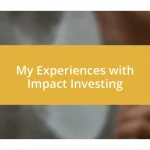Key takeaways:
- Understanding VCs requires grasping their focus on innovation, potential returns, and the importance of building relationships beyond the pitch.
- Crafting a compelling story, incorporating personal experiences, and showcasing key metrics can significantly enhance engagement and investor interest.
- Following up post-pitch with personalized communication and actively seeking feedback fosters relationships and opens doors for further discussions.

Understanding Venture Capitalists
Understanding venture capitalists is more than just knowing they fund startups; it’s about grasping their mindset. When I first encountered them, I was amazed by their focus on high potential returns. They’re not just investors; they’re partners seeking innovation and growth. What drives them? A desire to uncover the next big thing, which fuels their intense scrutiny of every detail in a pitch.
The experience of pitching to VCs is often overwhelming, and I vividly recall my nerves before one crucial meeting. I prepared for hours, not just rehearsing my presentation but also trying to predict their questions. The fear of being dismissed or, worse, not being understood lingered in my mind. They’re looking for clarity and enthusiasm, but they also want to see that you’ve done your homework and understand the market. Ask yourself, how can you capture their attention in just a few short minutes?
I learned that the journey doesn’t end with a great presentation. It’s about building relationships, too. After one of my pitches, I felt a mix of disappointment and relief when receiving feedback. The VCs valued my passion but saw gaps in my business model. Instead of viewing it as a setback, I reframed it as a learning opportunity. Their insights helped shape my next pitch and solidify my understanding of what VCs truly want. How will you take feedback and use it to your advantage?

Preparing Your Pitch Deck
When it comes to preparing your pitch deck, clarity is essential. I remember spending late nights crafting each slide, ensuring that every piece of information was straightforward and visually appealing. There’s a fine balance between providing enough detail to satisfy curiosity and overwhelming potential investors with too much information. Focus on your core message and draft your slides as a storytelling journey, guiding VCs through your vision with enthusiasm.
Visual elements can make a significant impact. I once saw a pitch deck that was overwhelmingly text-heavy; it didn’t leave a lasting impression. In contrast, my slides utilized engaging visuals and concise bullet points that drew the VCs in. I recommend incorporating graphs to depict market trends or customer data—these visuals can effectively reinforce your narrative, making complex ideas more accessible while showcasing your understanding of the market.
Finally, practice is key. The first time I presented my pitch, I stumbled over my words, and it was disheartening. However, with each rehearsal, I gained confidence and clarity in delivering my main points. I even recorded myself to identify areas for improvement—this technique highlighted necessary adjustments I would have otherwise overlooked. Your passion should shine through in every pitch, but flawless delivery often comes down to diligent preparation.
| Aspect | Tip |
|---|---|
| Content Clarity | Keep slides concise and focused on core messages. |
| Visual Design | Incorporate engaging visuals and graphs to illustrate points. |
| Rehearsal | Practice thoroughly to build confidence and refine delivery. |

Crafting a Compelling Story
Crafting a compelling story is the linchpin of a successful pitch. When I crafted my narrative, I leveraged my own journey and the challenges I faced. This personal touch not only humanized my pitch but also resonated with the investors. They want to connect with you and your vision, so it’s vital to weave your experiences and motivations into the story. Each slide wasn’t merely information; it was a piece of a larger narrative that painted a picture of what my startup could achieve.
Here are some key elements to consider when crafting your pitch story:
- Authenticity: Share your personal journey and the reason behind your passion for the project.
- Emotional Connection: Use anecdotes and experiences that elicit empathy and understanding from the audience.
- Clear Conflict: Highlight challenges you’ve faced and how overcoming them demonstrates resilience and innovation.
- Vision for the Future: Conclude with a strong, inspiring vision that showcases not just what your startup is today, but what it can become.
In my case, I vividly recounted a moment of failure in my early days. The way I pivoted in response showed the VCs my capacity for adaptation. I noticed their interest piqued as I articulated the specific lessons learned, making my journey relatable. They aren’t just investing in your product; they’re investing in you. The more intimately they understand your story, the more likely they will envision investing in your future.

Highlighting Key Metrics
Highlighting key metrics is crucial when presenting to VCs—it’s about showing your business’s potential in concrete terms. For example, when I pitched my startup, I didn’t just toss out numbers; I said, “Last quarter, our revenue grew by 40%, and our customer retention rate reached 95%.” These figures caught their attention and provided compelling evidence of our success. Key metrics act like a roadmap for investors, guiding them to understand where you’ve been and where you’re headed.
Moreover, I learned the power of visual representation when it comes to metrics. I incorporated a simple graph showcasing our user growth over the past year—it transformed abstract numbers into a story of momentum. Isn’t it fascinating how a visual can evoke excitement? When investors saw the upward trend, their eyebrows raised, signaling that my numbers had resonated. It’s vital to present data in ways that are both engaging and informative; it helps to solidify your narrative as credible.
Remember, different metrics matter to different investors. I once had a VC specifically ask for churn rate data, which I hadn’t anticipated. Luckily, I had it ready, and presenting it with a clear explanation illustrated our focus on customer satisfaction. This tailored approach not only demonstrated my preparedness but also my understanding of what drives their interests. So, what key metrics will you highlight to capture your investors’ interest?

Anticipating Questions and Concerns
Anticipating questions and concerns is essential when pitching to venture capitalists; it shows that you’ve done your homework and are prepared for dialogue. I vividly remember a moment during my pitch when a VC leaned forward and asked, “What’s your plan if your sales projections don’t materialize?” This question caught me off guard initially, but I was ready with a contingency plan based on market research and historical data from similar startups. How can you prepare for such inquiries? It’s about understanding your business inside and out, and considering potential pitfalls ahead of time.
Another critical aspect is to identify the common concerns VCs have, such as scalability and competitive advantages. During my preparation, I created a list of possible objections I might face. For instance, I anticipated concerns about competition and had a clear comparison chart ready, showcasing our unique value proposition. When I presented it, I felt the atmosphere shift; their skepticism turned into curiosity. Isn’t it rewarding when you can turn concerns into conversation? This proactive approach not only boosts your confidence but also reinforces your credibility as a founder.
Finally, remember that anticipating questions isn’t just about answering them—it’s about fostering a discussion. After addressing concerns, I often asked VCs if they had any other thoughts. Once, a seasoned investor offered insights on market trends that I hadn’t considered; it led to a deeper dialogue that benefited both of us. Engaging your audience in this way transforms a standard pitch into a collaborative exploration of potential, showing that you value their expertise as much as your own. How might you leverage such interactions to strengthen your pitch? It’s all part of building a relationship grounded in trust and shared ambition.

Following Up After the Pitch
Following up after a pitch is a critical step that many entrepreneurs overlook. After my last presentation, I sent a personalized thank-you email to each investor. It wasn’t just a quick note; I referenced specific points we discussed, which made the message feel genuine. This approach not only showed my appreciation but also reinforced my enthusiasm for our potential partnership. Don’t just be polite; be memorable.
In my experience, timing is everything when it comes to following up. I found that a week after the pitch is often the sweet spot. This timeframe keeps you fresh in their minds while not being too pushy. When I followed up with one particular VC, I included a relevant article about an industry trend we discussed. It sparked a conversation that ultimately led to a second meeting. Have you considered how a well-timed touchpoint can keep the momentum going?
Lastly, I learned the importance of feedback in these follow-ups. When I asked one investor for their thoughts on my pitch, it opened the door to an invaluable exchange. They shared insights about areas I could strengthen, which not only showed their interest but provided me with concrete ways to improve. Feedback shouldn’t be seen as criticism, but as a stepping stone for growth. What have you done to ensure that your follow-ups are not just ends, but beginnings of deeper discussions?

Lessons Learned from the Experience
One of the toughest lessons I learned was the importance of tailoring my pitch to the audience. In one instance, I pitched to a group that had a strong background in tech startups. I quickly realized that presenting my business’s financials without connecting them to the latest tech trends meant I lost their interest. This experience taught me to deeply understand the backgrounds of my investors and know what resonates with them. Have you considered how learning about your audience can shape a more impactful pitch?
Another key takeaway was the power of storytelling. I recall sharing a personal anecdote about how my passion for the product stemmed from a life-changing experience. The room shifted from a critical stance to one of genuine interest. When you weave personal stories into your pitch, it creates an emotional connection. Isn’t it fascinating how vulnerability can often be your strongest asset in a professional setting?
Finally, I discovered that humility can go a long way. After my pitch, I openly acknowledged gaps in my business model, sharing what I believed were areas requiring improvement. I feared it might make me appear weak, but instead, investors appreciated my honesty. This openness led to a more constructive dialogue; they saw me not just as a founder, but as a partner who values their expertise. Have you thought about the power of vulnerability in establishing trust during your pitches?















